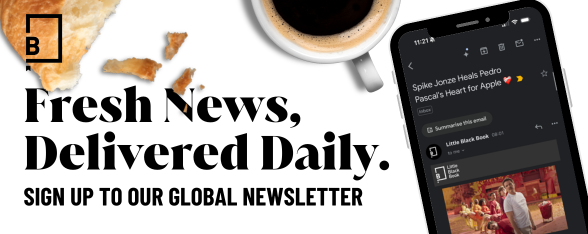
Brand Insight: Coca-Cola Latin America

Coca-Cola Latin America is fizzing with ideas that challenge the traditional approaches to advertising. Their in-house Innovation Lab system has changed the way they collaborate with agencies. By removing the need for briefs and putting faith in creatives’ abilities to generate inventive projects that chime with the brand’s values. Meanwhile, with Project Wired they’ve piloted a scheme to provide Wi-Fi access at Coca-Cola points of sale. LBB’s Laura Swinton caught up with Guido Rosales to find out more about how Coke is sharing the love across the region.
LBB> What are the region-specific challenges that Coca-Cola faces as a brand in Latin America?
GR> In Latin America, we have learned to be more innovative and flexible as a result of the many difficulties that we have had to overcome in the past, such as social and economic crises, downturns in consumption, and market instability. In order to survive we started doing more with less. We developed an instinct that enables us to see positive opportunities even during moments of crisis. We have adapted quickly to fluctuating markets conditions, and we brought creative solutions to an adverse environment.
LBB> And what are the region-specific challenges that you face as someone who works on the 'integrated' and digital side of things?
GR> Right now the biggest challenges that all integrated marketing professional are facing is how to deal with screen proliferation, the increasing amount of contact points with audiences; multiplicity of media consumption, the interaction between multiple screens and devices; and content evolution, because content is everything.
In terms of screen proliferation, the digital transformation of media is a reality that directly influences the increasing number of contact points within the audiences. If I ask you how many devices you have, you’re going to mention at least three or four (TV, laptop, smartphone, tablet, videogame console, for example). The challenge here is how brands will increase their share of attention. How do we connect with a person who is bombarded with thousands of stimuli? How are brands going to be relevant?
With multiplicity of media consumption audiences are changing their habits. The proliferation of new screens has provoked a diversification and fragmentation in media consumption. Right now, media habits are evolving faster than brands’ mix of media investments. With all that is going on, the old marketing model is no longer sustainable.
And finally there’s content evolution. The era of consuming one single medium at a time is over; on average, 60 per cent of people watch TV while they’re on their laptops, searching for things that they like or that seem to be pertinent. Relevant content is spreading and scaling in real time - with or without brand involvement.
All of this is creating the perfect storm. Brands that adapt to this new environment quickly will survive. Others may sink.
LBB> From an outsiders’ perspective it would be easy to lump Latin America into one homogeneous bloc, but there's a wealth of diversity within the region. As an example, Coca-Cola FM uses local agencies and DJs to ensure content is relevant to local listeners in different countries. How do you balance the need to appeal to different countries and cultures within the region whilst maintaining a coherent voice and strategy?
GR> In the past, in order to be relevant you needed to make sure your content was 80 per cent local and 20 per cent global. Right now, it’s the other way round. For example, we can see from YouTube that good content travels everywhere no matter where it originated. Of course, we still need to be closer to our audiences and as such, we need to promote and offer local content too.
In order to keep our brand message coherent across all countries, we develop and curate all content under the guidance of our brand values. In the case of Coca-Cola these are ‘Optimism’ and ‘Happiness’. If you compare the content and messages from Coke.FM or even Coke.TV, all of them are consistent across Latin America and across other regions outside LatAm. That’s because they originate from the same DNA and transmit the same human values.
LBB> Innovation Lab seems like an interesting, different approach to working with agencies and creatives. How would you describe or explain innovation lab?
GR>The Innovation Lab is our new philosophy of working with our marketing teams, our agencies and our technical partners. The goal is to develop unconventional ideas that can amplify our brand storytelling in a compelling and unique way. It is about working without a brief and trusting that our partners know enough about our brands to develop powerful work, keeping some seeding money aside and believing that ideas will come. It is also about speedy decision-making and – above all – maintaining a high level of mutual respect when it comes to judging ideas. It’s a trial and error process. We can fail, we know that, but ultimately we are learning and evolving.
LBB> How have agencies responded to Innovation Lab?
GR> Our agency partners have responded with some of the most powerful work we’ve created to date. They understand that in the current environment, only high quality and highly adaptable marketing will survive. Because of the flexible and fast-moving nature of the Innovation Lab model, we’re able to produce ideas that everyone’s excited about.
LBB> Project Wired aims to put Wi-Fi routers at Coca-Cola points of sale, in order to increase internet access. Where did this idea arise from and how will it change people's relationship with the brand?
GR> We want to democratise content and Internet access in Latin America. Many teenagers don’t have internet access because the cost is too high for them, so we want to put a WiFi router at every cooler and each point of sale, to spread happiness and utility to more young people. We want to create a better brand experience and generate more brand love.
LBB> How is the pilot for Project Wired progressing and what has the response been like?
GR> So far the results have been great. The pilot has been launched in Mexico and right now we are extending in Brazil. The average consumer engagement level, using this service, is around 20 to 30 minutes, and the store owners like the concept because it helps drive people to the stores and spend more time there.
LBB> By expanding internet access, Project Wired is an example of a brand not only creating a media platform for its own content, but also taking ownership of the hardware behind it. How do you see this developing in the future? Could it become commonplace for brands to supply internet access even in homes, for example?
GR> Our goal is to continue being relevant to people by creating an emotional bond with them. To do this it’s imperative to be where they are, to give them what they want. By giving them the chance to access the internet we enable them to reach out to their social networks, to consume the content that they love and to connect with their friends, this will create a unique and holistic experience for people.
We don’t want to be an Internet carrier - that is not our core business. We want to keep the brand relevant to teens, and be part of their popular culture.
LBB> What trends have caught your eye recently that you think will be important for Coca-Cola and other brands working in Latin America?
GR> The social environment is continuing to change, and the whole industry is re-thinking the way we generate resonance and relevance for our brands. We’re constantly adjusting to the different factors that affect environment, from technology to market and resource uncertainties.
Technology, as you know, is changing fast. Mobile innovation is leap-frogging computers, and smartphones and tablet penetration is growing year-on-year. The digital experiences of gaming, TV and social interaction together with the real world retail experience, are surprising us each and every day.
Market uncertainties are strongly influenced by the younger generations (Generation Y and the upcoming Generation Z) who are changing standard consumption habits. They are born digital, with digital brains. They are creating a new language using technology and if you don’t speak the same language, you’re out. They’re in search of new experiences, and they want to take action. They are not as passive as previous generations.
In this new environment, competition comes from everywhere; you’re not just up against the brands in your product category. All brands are competing for a share of attention in order to build an emotional bond with people. Consumers have more information, and more choices of products and services. They require more customisation and differentiation than ever before. Partnerships and alliances are rising all over the world.
Resource uncertainty arises from new talent inside organisations with new and different skills, and that requires new ways of motivating our employees. Organisations must take a more holistic approach, implementing structures that are more flexible and adaptable to the new environment.
Those who adapt quickly to these changes will lead the industry.
LBB> Coca-Cola Latin America started working with Twitter last year - how has that relationship grown and what has it brought to the brand? Which online channels are most important to Coca-Cola Latin America?
GR> The relationship that we have with Twitter are at the local markets level and each market develops its own local plans with them. They are just starting to put regional coordination in place. There are still huge opportunities to develop regional synergies with Twitter.
Our focus, though, is on our own channels; Coke.TV and Coke.FM are our key priorities right now. We are having amazing results with these platforms, and we want to continue to gain momentum, improving the content and bringing new partners to these channels.
LBB> You previously worked for Motorola - how do you think working on a technology and communications brand like that has influenced your approach to Coca-Cola?
GR> That’s a great question. Indeed, I’ve had two incredible experiences in my professional career. The first was when I moved from managing Quilmes Brand in Argentina, a CPG company (the main beer brand in the country) to the technology driven company, Motorola. That was a huge change and a great challenge. Later on, when I moved from Motorola back to CPG, the expertise in technology and innovation processes were very useful. They helped me to develop a holistic system and bring new approaches to the company. For example I was able to build a digital structure and consolidate processes to ensure our communications were innovative. It also helped with developing content that would amplify a brand conversation or create a better brand experience and, of course, building partnerships with tech partners.
LBB> Strategically, what are your aims for Coca-Cola Latin America in the next five years?
GR> The three challenges that I mentioned before: screen proliferation, multiplicity of media consumption and content evolution. We will continue to focus on streaming (content development, management and distribution) and developing better mobile experiences in order to build Brand Love and Value.















